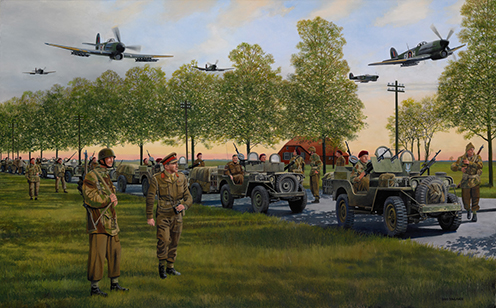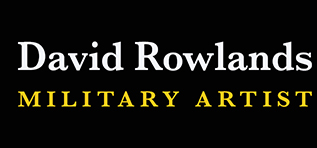« Click on Picture to
Return »
 |
|
5th SAS at Winschoten, Holland, 14 April 1945
Following distinguished service fighting the Japanese in Burma, Brigadier Michael Calvert DSO, an expert in unconventional warfare, took command of the Special Air Service (SAS) Brigade in north-west Europe in March 1945. During a conversation in 1997, he said to me, ‘David, this is a picture you ought to paint.’ He then described the scene in his mind’s eye: SAS armoured jeeps, ready to attack the Germans at Winschoten, lined up in single file as he stood with Major Eddy Blondeel in the evening light. He had called for air support, and RAF Typhoons roared overhead before firing their rockets at the enemy in front. I made a sketch under his supervision as he described it.
Formed in England in 1942, the Belgian Independent Parachute Company was an elite airborne unit consisting entirely of Belgian volunteers. In February 1944 it joined the SAS Brigade for operations in north-west Europe, and was known as 5th Squadron SAS. In April 1945, 5th SAS, by now consisting of two squadrons equipped with armoured jeeps commanded by Major Edouard Blondeel, was conducting offensive reconnaissance patrols ahead of the 1st Polish Armoured Division in the German-occupied Netherlands (Operation LARKSWOOD). On the approach to Winschoten the Germans had established an entrenched position. On 14th April, the jeeps attacked along the road, their machine guns blazing, but were met by a hail of machine gun and 20 mm anti-aircraft fire and forced to withdraw. Calvert, who had flown in by light aircraft, called for a “strafing” by rocket-firing Typhoons as evening approached, accompanied by artillery fire from the Poles. A new attack by 4 jeeps was met by intense fire and shelling from the coastal battery near the Dollart. Major Blondeel’s jeep was hit and burst into flames. Under cover of darkness the Germans withdrew, and at dawn the Belgians entered Winschoten. Every jeep participating in the attacks was hit by bullets, with one destroyed, but only a few men were wounded.
Col (Ret'd) Eddy Blondeel wrote to me, giving a detailed account of the action, a description of the jeeps, and a sketch map of the action.
Wilfried Van Haezendonck, archivist and historian at the Pegasus Museum, Diest, Belgium gave me much advice. His father was a corporal in 5th SAS at Winschoten, and wartime photographs enabled me to depict him in his jeep (named ‘Shangri La.’). During Operation LARKSWOOD in 1945, the jeeps no longer had a pair of fuel tanks in the rear. An armoured plate had been added in front of the radiator. Many jeeps towed two-wheeled trailers.
In London, the archivist of the SAS Association showed me a contemporary account of the action.
Thanks to Chris Charland, Senior Associate Air Force Historian, Royal Canadian Air Force; and to Chris Thomas, expert and author on the Hawker Typhoon, research established that the rocket-firing aircraft were from 164 Squadron RAF, which had to wait for the mist to clear before taking off at 18.15 hrs. Flying Officer Harry Bletcher’s personal flying book exists, and records the attack: S.W. Winschoten. Army support. All area well straffed. 3 attacks. No flak.
Harry’s Typhoon IB (serial no. RB455) bore the code letters FJ-H and I have depicted it at top right of the painting. It carried eight 60lb rocket projectiles. A photograph of this plane shows its four propeller blades and the nose painted black. Most (if not all) the aircraft had small repeats of their individual letters on the leading edges of the wings. The upper and lower wings of Typhoons in 164 Squadron had the same roundel as on fuselage sides (ie with narrow yellow outer ring), which was not unusual.
The painting belongs to the Belgian SAS Association.
Medium: Oil on Canvas
Printed image size(s): B2 only (58 x 38 cm)
Price(s): £75
|
|



